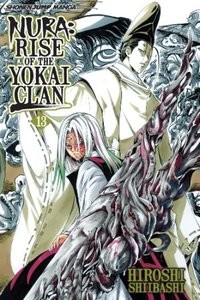RIGHT TURN ONLY!!
Neverwinter Knights
by Carlo Santos,

Seeing the news about the massive blizzard on the East Coast, I hope everyone out there is safe—but I'm also reminded how spoiled Southern Californians are. Don't be too envious of us, though: we have our own life-or-death hazards, including motorists who lose all driving ability when the roads become just the teensiest bit wet. I fear that I may have already transformed into that type of driver...
HAGANAI: I DON'T HAVE MANY FRIENDS

Vol. 2
(by Itachi and Yomi Hirasaka, Seven Seas, $12.99)
FROM THE BACK COVER:
"Hasegawa Kodaka, a boy with few friends, along with his beautiful classmate, the oddball Mikazuki Yozora, form the Neighbors Club, a group dedicated to making friends. While this sounds innocent enough, the only people who end up joining the club are total freaks and outcasts. Together, they geek out over RPG games, pit imaginary friends against each other, and wreak havoc in one another's lives while struggling to build social skills. Can black sheep like these really learn to become friends? And for a hot-blooded guy like Kodaka, why must everyone else in the club be females who are so attractive yet so insane?!"
EVIDENCE FOR:
Although Haganai seems to have a pointless premise—"socially awkward characters hang out and do nothing"—this volume proves that there is something to be gained from that idea. The cast's awkwardness turns out to be a prime source of comedy, whether it's Sena trying to argue that hentai games can be art (see, this series does tackle thought-provoking issues), acting out a screwed-up adaptation of Momotaro, or Kodaka trying to deal with his delusional vampire-wannabe sister. The characters' lively facial expressions and physically violent antics also add to the comedy—plus the loose, sketchy linework keeps the illustrations from looking too stiff. Haganai also starts to stretch its ambitions into drama and character development, with a flashback arc that explains why Kodaka doesn't have many friends (it's a bittersweet story) and a couple of bonding moments between him and Sena. It's a smart strategy: first they get you to laugh at the awkward weirdos, then they reveal personal details that make the weirdos worth caring about. Whether it's dishing out comedy or drama, though, the widely-spaced panels and minimal visual clutter serve the series well.
EVIDENCE AGAINST:
Haganai might have some winning comedy situations, but it still offers little in the way of an actual storyline. Take the chapter with Kodaka's sister, for example: it's practically filler, as she doesn't interact with any of the club members, and nothing she says or does affects Kodaka in later chapters. Even when he does interact with the major characters, though, their escapades remain sealed off in little one-chapter boxes. The hentai-game incident lasts exactly 26 pages, and that's the end of that forever (except as material for a future punchline). Then, when the series tries to get a serious story going, it relies on totally clichéd setups: Kodaka and Sena strengthen their friendship through a "sleazy guys hitting on the girl at the pool" scenario, which any romantic-comedy fan has witnessed many times. The other key plot point—a mysterious childhood friend in Kodaka's flashback—is no mystery at all, as the hints give it away and it relies on a contrived "lucky coincidence." Some may also find the artwork too plain, with its bland indoor settings and barely sketched-in backgrounds.
FINAL VERDICT:
Although still weak on the story end, the simple yet entertaining visuals and a biting sense of comedy make this volume worth a B.
HAYATE THE COMBAT BUTLER

Vol. 21
(by Kenjiro Hata, Viz Media, $9.99)
FROM THE BACK COVER:
"Surf! Sun! Gratuitous bikini shots! Battle nuns! Vacationing in the Greek isles, Hayate and the gang find all this and more. While Hinagiku works up the nerve to confess her feelings, Hayate battles thieves, swindlers and reprobates bent on winning the Sanzenin family fortune...and among them is none other than his mysterious childhood love, Athena..."
EVIDENCE FOR:
In this volume, Hayate the Combat Butler reminds us that its comedy toolbox goes well beyond just geeky anime references. This installment is most notable for its comical lineup of foes—the first being pompous rival Gilbert, whose challenge of a beach volleyball game against Hayate quickly escalates into insanity. Volleyball-playing robots? Class president Hinagiku flying into a rampage? Only in Hayate, folks. Then there's the avaricious nun who tries to steal the Sanzenin family's most prized heirloom ... but her own incompetence turns the escapade into a comedy of errors. If there's one thing better than frighteningly evil villains, it's the ones who are just hilariously bad at it. This volume also sneaks in some surprisingly sweet interludes: long-suffering underdog Nishizawa finally gets Hayate to herself for a second, and shares some sweet words with him as the Grecian sun sets over the ocean. (It's definitely one of those big-shot, planned-well-in-advance moments, as the landscapes and visual pacing are as close to perfect as this series has ever been.) Hinagiku's skittishness, and Nagi's blustery attitude toward Hayate, also keep the romantic merry-go-round in constant motion.
EVIDENCE AGAINST:
While this volume delivers the comedy goods, it does so without much of a game plan—each event just casually drifts into the next one, as if by accident. No thrilling explorations of underground caverns, no legitimately tough villain to challenge the hero, not even a tragic past to ferret out (the nun briefly recounting her back-story is as close as it gets). And speaking of tragic pasts, Athena's presence is hinted at but never capitalized on—she's just lurking constantly, muttering something like "I'll get you, Hayate" every few chapters or so. What a waste, to have the most important figure of Hayate's childhood sit around as an unused subplot. Moments of forced humor are another weak point for the series, usually whenever the characters go wink-wink nudge-nudge through the fourth wall. Their antics are already amusing enough without having to blatantly point it out. The biggest weakness of all, though, continues to be the art: character designs are too simple, background details are minimal, and the action shots are more messy than dynamic. Even the fanservice is a disappointment, with poses that look dry and unconvincing.
FINAL VERDICT:
It's as amusing as ever, but that's all it's got—this volume lacks a strong battle arc or plot direction. That and the mediocre visuals make this a C.
KNIGHTS OF SIDONIA

Vol. 1
(by Tsutomu Nihei, Vertical, $12.95)
FROM THE BACK COVER:
"Outer space, the far future.
A lone seed ship, the Sidonia, plies the void, ten centuries since the obliteration of the solar system. The massive, nearly indestructible, yet barely sentient alien life forms that destroyed humanity's home world continue to pose an existential threat.
Nagate Tanikaze has only known life in the vessel's bowels deep below the sparkling strata where humans have achieved photosynthesis and new genders. Not long after he emerges from the Underworld, however, the youth is bequeathed a treasured legacy by the spaceship's coolheaded female captain."
EVIDENCE FOR:
It's got a young man piloting a giant robot against alien enemies, but Knight of Sidonia is no Evangelion. Yet it's not as bleak or incomprehensible as Tsutomu Nihei works like Blame! or Biomega, either—rather, it's the best of both worlds, bringing Nihei's hard sci-fi mentality into a more conventional space-adventure environment. What biological changes would humanity undergo if they went into space? What traditional Earth customs would we keep, while transforming into a spacefaring society? Volume 1 answers thoughtful questions like that—but it also entertains with moments like Nagate in his robot battling against a monstrous beast, or getting into an unfortunate foot-chase because he (inadvertently) tried to steal a bag of rice. That last one reveals this series' humorous streak, as it examines how some of humanity's quirks linger well into the future. Nihei's art is another strong point, with incredible alien designs and spaceship interiors that prove he really does see the world on a different scale from everyone else. The sparse dialogue lets a lot of the action speak for itself—especially when Nagate is in the throes of battle—while strong black-and-white contrasts add to the visual impact.
EVIDENCE AGAINST:
Tsutomu Nihei doesn't like to use words very much—and unfortunately, the result is a story that often feels emotionally distant. When Nagate is out there, saying little about himself and only reacting to what others say, he barely even feels like a main character. To be fair, though, the other characters don't say much either, and this leads to a narrative flow that feels strangely abrupt. They just hop from scene to scene, sparing only a word or two, assuming that everyone is following right along with each plot development. Here's a tip, though: it doesn't hurt to explain, with a sentence or two, exactly what's going on. And it wouldn't hurt to have people chat with each other as friends, either. There's a character death early on that has little to no emotional impact, all because the relationship-building is so minimal in this volume. The lack of variety in character designs (apparently, it all comes down to hairstyle differences) also make it hard to follow who's who, and some of the messier battle scenes show that Nihei still goes overboard sometimes with the dystopian grunge art.
FINAL VERDICT:
Hopefully the characters will become more engaging by the second volume, but for now, this cool-headed space saga still hits enough of the right buttons for a B.
NEGIMA!

Vol. 37
(by Ken Akamatsu, Kodansha Comics, $10.99)
FROM THE BACK COVER:
"The war is over, and all that's left is to save the Magical World from imminent destruction. With the help of Asuna and others in his class, Negi is working to put his plan into effect. Meanwhile, Negi's students are realizing just what a heartbreaker the little boy has become."
EVIDENCE FOR:
What, you thought it'd be all over after Negi Springfield saved the world? Not a chance! Negima! still has plenty left to say, and this penultimate volume offers a cute, lighthearted coda. The girls who still think Negi's older-and-hotter form "Nagi" is the real deal finally get the punchline pulled on them; Negi's final sparring match with mentor Evangeline ends in comical fashion; a schoolwide sports day turns into a slapstick affair with Negi at its center. But these chapters also manage some genuinely poignant moments, like when fellow magicians reveal what really happened to Negi in his last great battle. It's also revealed that his closest companion, Asuna, has made a dramatic sacrifice of her own—which goes to show that Negima! still has some surprises in store. These chapters also have a number of eye-popping action sequences lined up, the best one being Negi and Evangeline's battle—two master wizards at the absolute top of their game, spinning out the most intense spells Ken Akamatsu can possibly draw. The sports festival, set among the meticulously drawn school grounds, is a dynamic, fast-paced visual stunner too.
EVIDENCE AGAINST:
Tying up loose plot ends is a necessary task, but it makes for weak, disjointed storytelling—especially when one has to count up all the girls Negi has magically kissed and then decide upon their fate. Some subplots are worth following, like what happens to Asuna (major impact on the story) or Yue (just plain sweet), but then there are all those third-tier characters who just aren't important anymore but Akamatsu has to do something with them. Hence the dull first three chapters, where various no-names interact with each other and Negi, as well as a block of dead-story-time between the Evangeline match and the sports festival. The extremely dense dialogue and artwork add another challenge in trying to get through these chapters—it's impossible to skim through when someone might have said something important, or there's a key bit of action one may have missed, and it's all so tiny. Even during major action scenes, the overly detailed art can be more of a hindrance than a help. How is anyone supposed to see Negi when he's covered by three layers of explosions?
FINAL VERDICT:
Without a world-ending battle to prop it up, this story arc is basically just spinning its wheels in place. Some light comedy and action earn it a C+, but not much more.
NURA: RISE OF THE YOKAI CLAN

Vol. 13
(by Hiroshi Shiibashi, Viz Media, $9.99)
FROM THE BACK COVER:
"While the day belongs to humans, the night belongs to yokai, supernatural creatures that thrive of human fear. Caught between these worlds is Rikuo Nura. He's three-quarters human, but his grandfather is none other than Nurarihyon, the supreme commander of the Nura clan, a powerful yokai consortium. So, Rikuo is an ordinary teenager three quarters of the time, until his yokai blood awakens. Then Rikuo transforms into the future leader of the Nura clan, leading a hundred demons.
Rikuo trains for a rematch against the yokai Tsuchigumo, who has his friend Yuki-Onna in his clutches. To get him up to par, Gyuki of the Nura clan has ordered Rikuo to attain a technique worthy of the Lord of a Hundred Demons in just three days. But time is running out and Rikuo hasn't gained anything but bumps and bruises. Will he be able to save Yuki-Onna?"
EVIDENCE FOR:
Hiroshi Shiibashi may only have one particular technique that sets him apart from other manga artists—his love of heavy, traditional-style brushstrokes—but he really knows how to use it to maximum advantage. This volume of Nura goes all-out with the flashy visuals: the aforementioned brushwork, heroic battle poses, demons and warriors wielding supernatural skills, and the gorgeous old temples of Kyoto being sacrificed as collateral damage. Each battle is a display of both power and elegance, especially as the volume approaches the last few chapters, where Rikuo and Tsuchigumo face off in a hotly-anticipated showdown. Yet this multi-front war also gives minor characters a chance to shine. Take Aotabo, for instance, who's been mostly a one-dimensional brute-force guy this whole time ... and at last he gets an inspiring back-story to complement his exploits on the battlefield. Other members of the Nura clan also prove essential in this story arc: when Rikuo finally gets the big power-up he's been training for, it's his bonds of friendship with others that make it happen. And it's those same bonds (along with epic, sword-slashing attacks, obviously) that make the Tsuchigumo battle so thrilling when it finally comes.
EVIDENCE AGAINST:
This volume culminates in a marquee matchup, but it's the undercard fights that are a pain to sit through. Chaos takes over this volume's first half, as it mops up a battle from last volume (the end result, needless to say, is unsatisfying), then flits back and forth between different subplots until settling on Aotabo's situation. Even then, the story can't seem to decide whether to tell Aotabo's back-story or hone in on his fight, so it just splits it into fragments. Rikuo's preparation for the big fight fares somewhat better, but with so many folks involved in the boy's training, there'll probably be a few moments where one has to pause and think, "Who are all these characters and what are they here for?" The various bad-guy minions and supporters might elicit a similar response—this series just has too many minor characters to keep track of. The artwork also looks to be the product of a disorganized mind, with speedlines and explosive effects so dense that they add confusion rather than excitement to the page. And yes, all those extra characters standing around add to the clutter too.
FINAL VERDICT:
Despite a disjointed start, and artwork that sometimes gets in its own way, the excitement of Rikuo and Tsuchigumo facing off makes this volume worth a B-.

AMEIRO PARADOX

Vol. 1
(by Isaku Natsume, Shinshokan, ¥600)
FROM THE BACK COVER:
"Onoe, a reporter at a weekly magazine, gets a department transfer that has him doing stakeouts with photographer Kaburagi. Not only does Onoe see him as a rival, but he also finds that Kaburagi's unscrupulous methods for gathering a scoop are an affront to his strong sense of justice. Right away, the two of them don't get along, but as they chase various news leads together, could it be that mutual feelings are starting to develop...?"
EVIDENCE FOR:
Yes, it's BL, so everyone knows where this is going ... but it's how it gets there that makes Ameiro Paradox such a great read. Not content to just be a "two guys hate each other until one of them realizes he's in love and BOOM" series, Volume 1 actually sees Onoe and Kaburagi taking turns at being the unrequited lover—their feelings flip-flop back and forth until the last-chapter resolution. What also sets the series apart is that it's about more than just two men falling in love—it also works as an exposé of Japan's underhanded, scandal-obsessed weekly magazines, much like how Sekaiichi Hatsukoi happened to be a handy primer on the manga business. So when they get into arguments about the morality of Kaburagi's methods, it's not just their relationship growing more intense, but also a legitimate debate about journalistic ethics. In other words, a story you can appreciate on two levels. The art isn't going to win any awards, but it does hit that ideal balance between discreet and explicit during the love scenes, and the simple, dialogue-driven layouts make it easy to follow.
EVIDENCE AGAINST:
See, that's the problem: it's BL, so everyone knows where it's going. Even if it has to come up with ridiculous contrivances to get there (He loves him! Then he doesn't! But he does!), or switch into hot-and-steamy mode at bizarre, unexpected times. The pacing works pretty well when Onoe and Kaburagi are just arguing, but then comes the physical contact, which always seems to come out of nowhere. The series also has trouble coming up with anything outside of a repetitive chapter-by-chapter formula: Onoe and Kaburagi go on stakeout, they score a big-time scoop, then they argue with each other for a bit. Repeat until the two guys make out. The art, meanwhile, actually does deserve an award: an award for being horrible. Chapter 1 in particular is a garbage heap of amateurishness, with no screentones, roughly drawn lines, and practically no backgrounds to speak of. The later chapters fare better (must've gotten assistants), but the series' visual style is still built on the usual BL clichés of wispy male characters, talking-head scenes, and (even worse) big panels of nothing but dialogue.
FINAL VERDICT:
Despite the obvious adherence to formula, the series still does enough things right to be an audience-pleaser. Fans can enjoy it as a workplace drama, as a BL romance, or both.

A new challenger appears! After a call for fresh Reader's Choice submissions, the fans have answered. This week, M. Kimball steps up to offer some thoughts on another "hidden gem" title.
Do you want to share your favorite underrated/overlooked manga with other fans? Don't be shy—send a review to Reader's Choice and you can become part of the conversation!
LAND OF THE BLINDFOLDED

Vols. 1-9
(by Sakura Tsukuba, CMX, $9.99 ea. [out of print])
A balm for the shojo fan burned out on angst ridden relationships and back stabbing friends can be found in a sweet little series called Land of the Blindfolded. It centers around Kanade Otsuka, an average high school girl with a supernatural twist. She likens her ability to a blindfold which has slipped, occasionally allowing her to view the future of a person she touches. Her companions, Arou Naitou and Masahiro Namiki, have lost their blindfolds altogether and can see at will the past and future, respectively. Because this is shojo, a continuing theme is the gently budding relationship between Kanade and Arou which does indeed have all of the engaging elements of a first love. But more than a romance, the series is about friendship: a trio of misfits who grow together and help each other through the rough times.
Interwoven with the usual school life happenings of festivals, club activities, and studying for exams are problems caused by or solveable with their powers. In the beginning Namiki uses his ability only for self-gain and Arou doesn't believe in using his clairvoyance to assist others. But Kanade, despite having her own fears about touching others, has a relentlessly optimistic disposition which is determined to see the best in people and she encourages her talented friends to help those who can't see. She is also the first to offer a smile and support when a vision is traumatic, when recipients of advice react with anger and distrust, or when painful familial ghosts haunt the present.
Sakura Tsukuba's character designs support her narrative style: easy on the eyes, slightly ethereal, with a fairly balanced sense of anatomy despite the occasional awkward pose. Backgrounds tend to be light on detail, but contain enough of a setting to convey the mood. At times you can feel the mangaka's nostalgia for her own school days. The first chapter, which was originally intended as a one shot, is a little rough around the edges, but quickly enough the characters and pacing start to mellow and drawings become more refined.
Unfortunately, Land of the Blindfolded is an older series, released by the now defunct CMX and so no longer in print. But used copies are still floating around in public libraries and online bookstores and this charming series is worth finding to curl up with on a rainy afternoon.
Is there a hidden gem of manga you'd like to reveal to the world? Is there a piece of garbage that deserves to be bashed in public? Or is there a title that didn't get a fair grade here, and you want to set the record straight?
Now's YOUR chance to be the reviewer! Write a review of about 300-400 words (a little more or less is fine) and include:
- Your name
- Title of manga (and volume no., if applicable)
- Author/Artist
- Publisher
- Briefly describe the story, then explain why this manga is great, terrible, or in between. Be objective, but also be entertaining.
Then send it in to rtoreaders (at) gmail (dot) com (plain text format preferred). One review will be selected out of all the submissions and will be published in the next column. All types of manga and manga-inspired comickry are accepted, from past and present, from Japan and beyond—what matters is that it's the Reader's Choice! NOTE: Submissions may be edited for formatting and grammar.
discuss this in the forum (5 posts) |